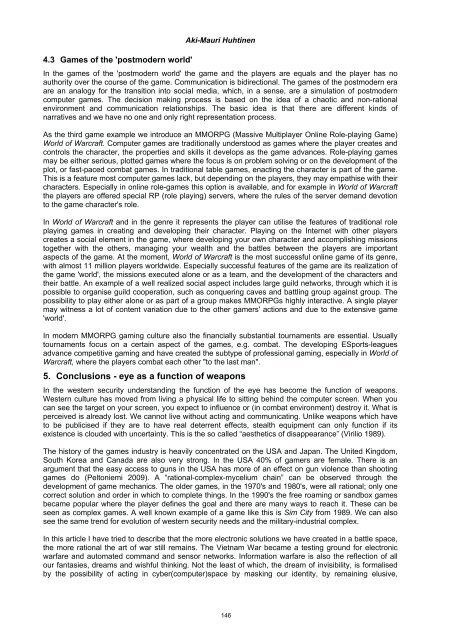(in) Security - Academic Conferences Limited
(in) Security - Academic Conferences Limited
(in) Security - Academic Conferences Limited
Create successful ePaper yourself
Turn your PDF publications into a flip-book with our unique Google optimized e-Paper software.
4.3 Games of the 'postmodern world'<br />
Aki-Mauri Huht<strong>in</strong>en<br />
In the games of the 'postmodern world' the game and the players are equals and the player has no<br />
authority over the course of the game. Communication is bidirectional. The games of the postmodern era<br />
are an analogy for the transition <strong>in</strong>to social media, which, <strong>in</strong> a sense, are a simulation of postmodern<br />
computer games. The decision mak<strong>in</strong>g process is based on the idea of a chaotic and non-rational<br />
environment and communication relationships. The basic idea is that there are different k<strong>in</strong>ds of<br />
narratives and we have no one and only right representation process.<br />
As the third game example we <strong>in</strong>troduce an MMORPG (Massive Multiplayer Onl<strong>in</strong>e Role-play<strong>in</strong>g Game)<br />
World of Warcraft. Computer games are traditionally understood as games where the player creates and<br />
controls the character, the properties and skills it develops as the game advances. Role-play<strong>in</strong>g games<br />
may be either serious, plotted games where the focus is on problem solv<strong>in</strong>g or on the development of the<br />
plot, or fast-paced combat games. In traditional table games, enact<strong>in</strong>g the character is part of the game.<br />
This is a feature most computer games lack, but depend<strong>in</strong>g on the players, they may empathise with their<br />
characters. Especially <strong>in</strong> onl<strong>in</strong>e role-games this option is available, and for example <strong>in</strong> World of Warcraft<br />
the players are offered special RP (role play<strong>in</strong>g) servers, where the rules of the server demand devotion<br />
to the game character's role.<br />
In World of Warcraft and <strong>in</strong> the genre it represents the player can utilise the features of traditional role<br />
play<strong>in</strong>g games <strong>in</strong> creat<strong>in</strong>g and develop<strong>in</strong>g their character. Play<strong>in</strong>g on the Internet with other players<br />
creates a social element <strong>in</strong> the game, where develop<strong>in</strong>g your own character and accomplish<strong>in</strong>g missions<br />
together with the others, manag<strong>in</strong>g your wealth and the battles between the players are important<br />
aspects of the game. At the moment, World of Warcraft is the most successful onl<strong>in</strong>e game of its genre,<br />
with almost 11 million players worldwide. Especially successful features of the game are its realization of<br />
the game 'world', the missions executed alone or as a team, and the development of the characters and<br />
their battle. An example of a well realized social aspect <strong>in</strong>cludes large guild networks, through which it is<br />
possible to organise guild cooperation, such as conquer<strong>in</strong>g caves and battl<strong>in</strong>g group aga<strong>in</strong>st group. The<br />
possibility to play either alone or as part of a group makes MMORPGs highly <strong>in</strong>teractive. A s<strong>in</strong>gle player<br />
may witness a lot of content variation due to the other gamers' actions and due to the extensive game<br />
'world'.<br />
In modern MMORPG gam<strong>in</strong>g culture also the f<strong>in</strong>ancially substantial tournaments are essential. Usually<br />
tournaments focus on a certa<strong>in</strong> aspect of the games, e.g. combat. The develop<strong>in</strong>g ESports-leagues<br />
advance competitive gam<strong>in</strong>g and have created the subtype of professional gam<strong>in</strong>g, especially <strong>in</strong> World of<br />
Warcraft, where the players combat each other "to the last man".<br />
5. Conclusions - eye as a function of weapons<br />
In the western security understand<strong>in</strong>g the function of the eye has become the function of weapons.<br />
Western culture has moved from liv<strong>in</strong>g a physical life to sitt<strong>in</strong>g beh<strong>in</strong>d the computer screen. When you<br />
can see the target on your screen, you expect to <strong>in</strong>fluence or (<strong>in</strong> combat environment) destroy it. What is<br />
perceived is already lost. We cannot live without act<strong>in</strong>g and communicat<strong>in</strong>g. Unlike weapons which have<br />
to be publicised if they are to have real deterrent effects, stealth equipment can only function if its<br />
existence is clouded with uncerta<strong>in</strong>ty. This is the so called “aesthetics of disappearance” (Virilio 1989).<br />
The history of the games <strong>in</strong>dustry is heavily concentrated on the USA and Japan. The United K<strong>in</strong>gdom,<br />
South Korea and Canada are also very strong. In the USA 40% of gamers are female. There is an<br />
argument that the easy access to guns <strong>in</strong> the USA has more of an effect on gun violence than shoot<strong>in</strong>g<br />
games do (Peltoniemi 2009). A “rational-complex-mycelium cha<strong>in</strong>” can be observed through the<br />
development of game mechanics. The older games, <strong>in</strong> the 1970's and 1980's, were all rational; only one<br />
correct solution and order <strong>in</strong> which to complete th<strong>in</strong>gs. In the 1990's the free roam<strong>in</strong>g or sandbox games<br />
became popular where the player def<strong>in</strong>es the goal and there are many ways to reach it. These can be<br />
seen as complex games. A well known example of a game like this is Sim City from 1989. We can also<br />
see the same trend for evolution of western security needs and the military-<strong>in</strong>dustrial complex.<br />
In this article I have tried to describe that the more electronic solutions we have created <strong>in</strong> a battle space,<br />
the more rational the art of war still rema<strong>in</strong>s. The Vietnam War became a test<strong>in</strong>g ground for electronic<br />
warfare and automated command and sensor networks. Information warfare is also the reflection of all<br />
our fantasies, dreams and wishful th<strong>in</strong>k<strong>in</strong>g. Not the least of which, the dream of <strong>in</strong>visibility, is formalised<br />
by the possibility of act<strong>in</strong>g <strong>in</strong> cyber(computer)space by mask<strong>in</strong>g our identity, by rema<strong>in</strong><strong>in</strong>g elusive,<br />
146

















